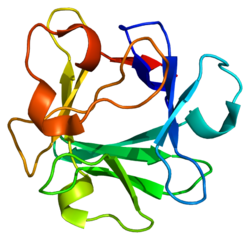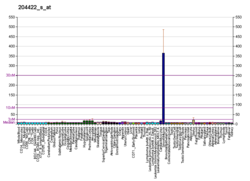
Back عامل نمو الأرومة الليفية القاعدي Arabic عامل النمو الفيبروبلاستى الاساسى ARZ FGF2 Welsh Basic fibroblast growth factor English فاکتور رشد فیبروبلاستی بازی Persian Factor de crecemento de fibroblastos básico Galician 塩基性線維芽細胞増殖因子 Japanese FGF2 Ukrainian
FGF2, znan i kao osnovni fibroblastni faktor rasta (bFGF) i FGF-β, jest faktor rasta, signalni protein koji je kod ljudi kodiran genom FGF2 sa hromosoma 4.[5][6] Veže se za i vrši efekte preko specifičnih proteina receptora faktora rasta fibroblasta (FGFR) , koji su sami po sebi porodica blisko povezanih molekula. Faktor rasta fibroblasta je prvi put prečišćen 1975. godine; ubrzo nakon toga izolovane su tri varijante: osnovni FGF (FGF2); heparin-vezujući faktor rasta-2; i faktor rasta endotelnih ćelija-2. Sekvenciranje gena je otkrilo da je ova grupa isti protein FGF2 i da je član porodice proteina faktora rasta fibroblasta.[7][8]
- ^ a b c GRCh38: Ensembl release 89: ENSG00000138685 - Ensembl, maj 2017
- ^ a b c GRCm38: Ensembl release 89: ENSMUSG00000037225 - Ensembl, maj 2017
- ^ "Human PubMed Reference:". National Center for Biotechnology Information, U.S. National Library of Medicine.
- ^ "Mouse PubMed Reference:". National Center for Biotechnology Information, U.S. National Library of Medicine.
- ^ Dionne CA, Crumley G, Bellot F, Kaplow JM, Searfoss G, Ruta M, Burgess WH, Jaye M, Schlessinger J (septembar 1990). "Cloning and expression of two distinct high-affinity receptors cross-reacting with acidic and basic fibroblast growth factors". The EMBO Journal. 9 (9): 2685–92. doi:10.1002/j.1460-2075.1990.tb07454.x. PMC 551973. PMID 1697263.
- ^ Kim HS (1998). "Assignment1 of the human basic fibroblast growth factor gene FGF2 to chromosome 4 band q26 by radiation hybrid mapping". Cytogenetics and Cell Genetics. 83 (1–2): 73. doi:10.1159/000015129. PMID 9925931. S2CID 33214466.
- ^ Greška kod citiranja: Nevaljana oznaka
<ref>; nije naveden tekst za reference s imenompmid 1785797 - ^ Burgess WH, Maciag T (1989). "The heparin-binding (fibroblast) growth factor family of proteins". Annual Review of Biochemistry. 58: 575–606. doi:10.1146/annurev.bi.58.070189.003043. PMID 2549857.






